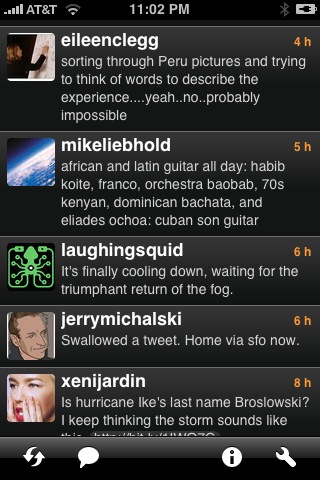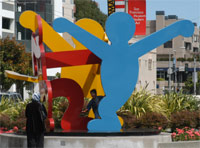 I was reading Dion Hinchcliff’s “50 Essential Strategies for Creating a Successful Web 2.0 Product” (you should go read it when you have more time) and I’ve cherry-picked the points that ring true for me. His points are good and very interesting, but some are real gems of wisdom[1]. And I’ll add some of my own observations to this article. I’ll limit mine to 10 and if you’re ambitious you can read the 50 in his blog. One of the overarching principles is that, as he says, “The Web Community Gets Smarter Every Time It Builds A Product” – which I will exend to add that we marketers and developers are constantly learning, and the more we involve people early in our development processes, and the more closely we listen to them, the faster and better our development cycles will be.
I was reading Dion Hinchcliff’s “50 Essential Strategies for Creating a Successful Web 2.0 Product” (you should go read it when you have more time) and I’ve cherry-picked the points that ring true for me. His points are good and very interesting, but some are real gems of wisdom[1]. And I’ll add some of my own observations to this article. I’ll limit mine to 10 and if you’re ambitious you can read the 50 in his blog. One of the overarching principles is that, as he says, “The Web Community Gets Smarter Every Time It Builds A Product” – which I will exend to add that we marketers and developers are constantly learning, and the more we involve people early in our development processes, and the more closely we listen to them, the faster and better our development cycles will be.
[Read more…]
Jerry’s “Law of Convenience”
I guess them that passes the laws first will get the kudos. So here’s some credit, and honestly if you google around you won’t find this law anywhere else. This is so simple yet it’s the basis of everything we do (and many things we overlook) every day online… Jerry Michalski’s “Law of Convenience.”
Every additional step that stands between people’s desires and the fulfillment of those desires greatly decreases the likelihood that they will undertake the activity.
Jerry reminds us that even one little impediment – one additional click; an additional password; a confirmation – can stand in the way of a product’s being used or not. Ya, everybody already knows this, but a reminder every once in a while is welcome because we sometimes get overly-impressed with the features of the products we’re designing and think that people will love them so much they won’t mind all of the extra steps and clicks.
Google Earth as a visual-access tool
![]() Google Earth can be viewed as a “browser” for people who are visually and spatially oriented. It lets them access information from around the world, using the planet itself as their visual/spatial reference point. For our new Project Happiness, we are anticipating we’ll receive posted video, audio, photos and other artistic contributions from schools and students around the world, and Google Earth will be one of the “portals” that people can use to sort out this information.
Google Earth can be viewed as a “browser” for people who are visually and spatially oriented. It lets them access information from around the world, using the planet itself as their visual/spatial reference point. For our new Project Happiness, we are anticipating we’ll receive posted video, audio, photos and other artistic contributions from schools and students around the world, and Google Earth will be one of the “portals” that people can use to sort out this information.
To find examples of Google Earth being used by nonprofits, check the Google Earth outreach web site. There are many, many specific example on the outreach showcase page.
Twitter made me (not) do it
It’s been a whole month since I wrote anything in my blog? What happened? (Or rather, what did not happen?)
Well, let’s just blame it on Twitter. Or on the new iPhone. Or on two clients wanting 70-hour weeks from me all month. Or on processing 4 hours of teacher training videos.
Nah, let’s just blame it on Twitter.
Twitter seems to have taken a big bite out of my blogging energy lately.
 I primarily use Twitteriffic on my iPhone to both follow and to create new tweets, but I also love Twitterfox (a plug-in for the FIreFox browser) if I’m at a computer (it just pops up a little panel showing the most recents, and lets me quickly twipe a new tweet whenever I feel the need.
I primarily use Twitteriffic on my iPhone to both follow and to create new tweets, but I also love Twitterfox (a plug-in for the FIreFox browser) if I’m at a computer (it just pops up a little panel showing the most recents, and lets me quickly twipe a new tweet whenever I feel the need.
But why do I even bother with Twitter? – because I get stoked with a dozen new ideas every day! In the old days, “kids” used Twitter to vacuously and narcissistically communicate “I’m having breakfast” or “I’m on the bus” or “I’m at the coffee shop.” But somehow a large number of busy people realized that not only was this a waste of a good communication medium, but something better could actually be done with it – and now what we do is communicate concepts, places, activities and ideas of interest to our group. Someone might be experiencing writer’s block and need inspiration and put out a call for help that explains the concept she’s working on, and get back a half dozen interesting tangential ideas! Another might have returned from a trip and posted photos – and will put up a tweet pointing to the photos. Someone else will be at a conference and will tweet about each speaker’s primary concept.
You have to carefully pick who you “follow” (whose tweets you subscribe to) on Twitter, but once you have your list tuned well, you have constructed a channel that lets you really stay in touch with the ideas and activities that will surface as blog posts and news in the next 24 to 48 hours. And you get a real boost from knowing what your friends and colleagues are working on and thinking about.
Bye Bye SMS
 My real-world mixed-reality games were originally built to depend primarily on SMS (AKA “TXT” in the US) messaging. As the years went on (I started this in 2002) I found that I had to develop the games further so they could be played by email. As they became more location-independent, playing by email made more sense, and people really wanted to play by regular email rather than just on phones.
My real-world mixed-reality games were originally built to depend primarily on SMS (AKA “TXT” in the US) messaging. As the years went on (I started this in 2002) I found that I had to develop the games further so they could be played by email. As they became more location-independent, playing by email made more sense, and people really wanted to play by regular email rather than just on phones.
Then came the iPhone. And rich (HTML) email entered the picture for mobile devices. And richer and longer in-game responses from players. (SMS is only 160 characters, while email doesn’t have this limit, and thus is so much more fun.)
Well, over time that changed. Sometimes text messages are delayed for a substantial time (can tale hours), and our games are real-time so any delay beyond say one minute is a catastrophe. And then more and more phones became capable of sending text messages to email addresses – it had only been T-Mobile at first, and now it’s most phones. Today, at least 50% of phones in the US are capable of sending/receiving email, even thru the SMS mechanisms (there is an SMS-to-email interface on all systems).
 So we’ve made a number of improvements in our games that permit play from regular email as well as mobile email-capable devices like phones, PDAs and smartphones.
So we’ve made a number of improvements in our games that permit play from regular email as well as mobile email-capable devices like phones, PDAs and smartphones.
And it looks like 2008 may be the year that we’ll develop more of these new, rich street games based on HTML email, and still played from mobile devices like the iPhone.
Yesterday (July 31st) we sat down and planned the trajectory for the next few such experience for YBCA – this is going to be fun. Watch for more on this as we announce the next YBCA game (October).
